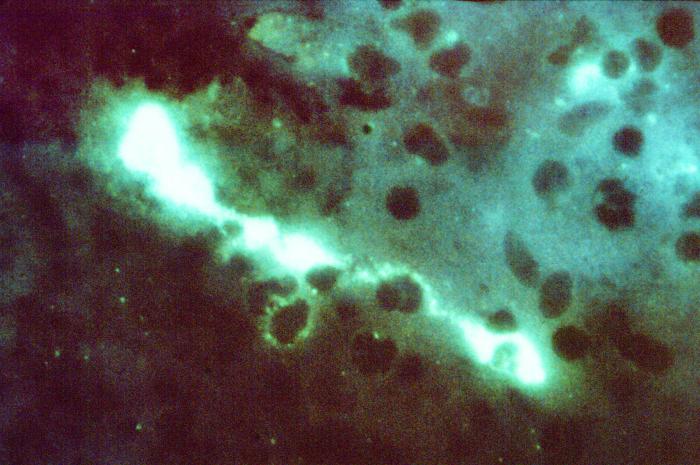Chlamydophila psittaci
For the WikiDoc page for this topic, click here
Editor-In-Chief: C. Michael Gibson, M.S., M.D. [1]; Associate Editor-In-Chief: Mohammed A. Sbeih, M.D. [2]Omodamola Aje B.Sc, M.D. [3]
| Chlamydophila psittaci | ||||||||||||
|---|---|---|---|---|---|---|---|---|---|---|---|---|
 Direct fluorescent antibody stain of a mouse brain impression smear showing C. psittaci.
| ||||||||||||
| Scientific classification | ||||||||||||
|
|
Psittacosis Microchapters |
|
Diagnosis |
|---|
|
Treatment |
|
Case Studies |
|
Chlamydophila psittaci On the Web |
|
American Roentgen Ray Society Images of Chlamydophila psittaci |
|
Risk calculators and risk factors for Chlamydophila psittaci |
Overview
Psittacosis is caused by the organism Chlamydia psittaci. Chlamydia is understood to be a Gram-negative bacterium belonging to the genus Chlamydia or Chlamydophila in the family of Chlamydiaceae together with Parachlamydiaceae, Waddliaceae and Simkaniaceae in the order Chlamydiales, class and phylum Chlamydiae. Chlamydiales are obligate intracellular infectious agents in eukaryotic cells characterized by a unique developmental replication cycle.[1]
Causes
- Birds are the major zoonotic reservoir. Despite its name, C. psittaci infection has been documented in 467 species from 30 bird orders, from psittaformes to ostriches to penguins have all been found to be associated with the development of psittacosis.[2]
- Bird handlers and those who keep birds as pets have a higher prevalence of the disease.
- C. psittaci may be classified into eight serovars according to variation in the major outer membrane protein (MOMP): serovar A to F, WC and M56.[3]
Table 1: Classification of Chlamydophila psittaci into 8 serovars[4]
| Serovar | Genotype | Predominant host order | Human infection documented |
|---|---|---|---|
| A | A | Psittaformes
|
Yes |
| B | B | Columbiformes
|
Yes |
| C | C | Anseriformes
|
Yes |
| D | D | Galliformes
|
Yes |
| E | E | Struthioniformes
|
Yes |
| F | F | Isolated from single parakeet and turkey only | Yes |
| WC | G | Cattle | No |
| M56 | H | Rodents | No |
| E/B | Ducks | Yes |
References
- ↑ de Rossi G, Focacci C (1979). "Early detection of craniosynostosis by 99mTc-pyrophosphate bone scanning". Radiol Diagn (Berl). 20 (3): 405–9. PMID 229510.
- ↑ Beeckman, D.S.A.; Vanrompay, D.C.G. (2009). "Zoonotic Chlamydophila psittaci infections from a clinical perspective". Clinical Microbiology and Infection. 15 (1): 11–17. doi:10.1111/j.1469-0691.2008.02669.x. ISSN 1198-743X.
- ↑ Vanrompay D, Butaye P, Sayada C, Ducatelle R, Haesebrouck F (1997). "Characterization of avian Chlamydia psittaci strains using omp1 restriction mapping and serovar-specific monoclonal antibodies". Res Microbiol. 148 (4): 327–33. doi:10.1016/S0923-2508(97)81588-4. PMID 9765811.
- ↑ Balter S, Janower ML (1975). "The use of photochromic eyeglasses by radiologists". Radiology. 116 (02): 450. doi:10.1148/116.2.450. PMID 1153750.